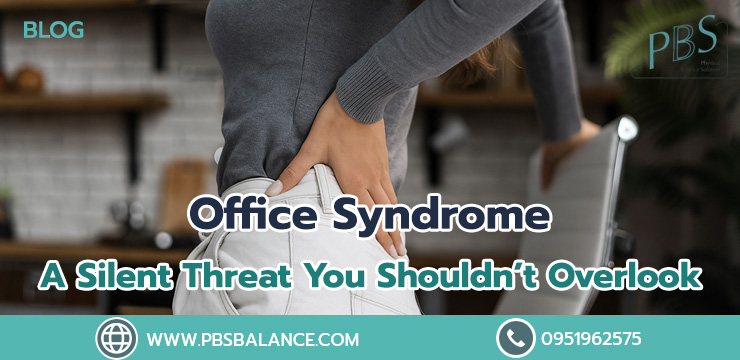
Office syndrome refers to a cluster of musculoskeletal and neurological symptoms caused by prolonged sedentary behavior and poor posture, commonly observed in office workers who spend extended periods seated at a computer in repetitive or static positions. Although office syndrome is not classified as a disease, and symptoms may be temporarily alleviated through massage or stretching, neglecting this condition can lead to serious musculoskeletal and spinal complications.
Causes
The primary cause of office syndrome is the sustained overuse of muscles under ergonomically harmful conditions. Common contributing factors include:
- Prolonged sitting with improper posture due to inadequately designed desks or workstations
- Incorrect positioning of computer monitors and keyboards
- Forward head posture when viewing smartphones
- Repetitive forward bending or slouching
These factors result in continuous muscle tension. Over time, this leads to muscular fatigue, weakness, and compensatory stiffness in adjacent muscle groups.
Symptoms and Associated Conditions
Office syndrome may present with a variety of musculoskeletal, neurological, and systemic symptoms, including:
- Lower and upper back pain due to poor sitting posture
- Myofascial pain syndrome: Chronic neck, shoulder, and scapular pain
- Carpal Tunnel Syndrome: Numbness, tingling, and pain in the hands, wrists, and forearms due to compression of the median nerve at the wrist
- Tendinitis: Inflammation of tendons in the elbows, wrists, fingers, thighs, and other regions
- Trigger Finger or Joint Stiffness: Pain, limited range of motion, and stiffness in finger joints—especially the ring and thumb—when extending or flexing
- Patellofemoral Pain Syndrome: Pain localized at the front of the knee and around the patella (kneecap)
- Ocular strain and tension headaches from prolonged screen time
- Psychological symptoms, including depression, insomnia, and chronic fatigue
- Gastrointestinal discomfort: Indigestion, bloating, nausea, and belching
Prevention Strategies
Preventing office syndrome is achievable through simple behavioral and ergonomic adjustments:
- Correct Posture Alignment
Sit upright with shoulders relaxed and retracted. Tuck the chin slightly to maintain cervical spine alignment. Thighs should be parallel to the floor. Position the computer monitor at arm’s length and at eye level. Ensure that the keyboard and mouse are within comfortable reach, allowing for relaxed placement of the arms and wrists. - Frequent Postural Adjustment
Avoid remaining in one position for prolonged periods. Take breaks every 1–2 hours to stretch or walk around. Regular movement helps prevent muscle fatigue and promotes proper posture. Additionally, rest the eyes periodically to reduce visual strain. - Adequate Lighting
Sit near a window or ensure sufficient ambient lighting. Natural light helps reduce eye fatigue, enhances alertness, and improves overall work performance. - Regular Physical Activity
Engage in consistent exercise to stretch tight muscles and strengthen core musculature. This helps alleviate chronic musculoskeletal pain and prevents future episodes. - Limit Harmful Behaviors
Avoid prolonged use of smartphones and tablets. Excessive screen time in poor posture may lead to chronic neck, shoulder, and upper back discomfort. - Ensure Sufficient Rest
Adequate sleep, balanced nutrition, and proper hydration are essential for maintaining overall health and musculoskeletal recovery.
When to Seek Medical Attention
If lifestyle modifications fail to resolve chronic muscle pain, it is advisable to consult a physician promptly to prevent further complications. Symptoms such as persistent numbness, tingling, or electric shock-like sensations may indicate underlying spinal disc herniation or nerve compression requiring medical intervention.
Conclusion
Office syndrome is a manageable condition and not as daunting as it may seem—provided that early intervention and behavioral changes are implemented. However, if symptoms persist despite preventive measures, it is crucial to consult a specialist without delay. At PBS, we offer consultation services to address chronic office syndrome, helping patients avoid prolonged pain and unnecessary healthcare costs associated with delayed treatment or short-term symptomatic relief.
If you continue to experience persistent foot pain despite trying all natural treatment methods, consult a specialist promptly. At PBS, our team of foot care specialists provides services including custom orthotic insoles for plantar fasciitis and corrective devices for foot alignment. These solutions are personalized to treat the root cause and deliver the best possible outcomes.
Facebook: PBSofficial.TH
LINE Official Account: @pbs.official